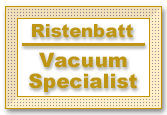A Two-Motor Power Team is a type of vacuum cleaner that teams a canister type vacuum cleaner with a motorized power nozzle. The powerful brushing action of the power nozzle, combined with the strong suction of the "clean-air" suction motor, enables a power team to perform very well deep cleaning carpets as well as cleaning all other types of surfaces. A central vacuum system with a motorized power nozzle is a unique type of power team in that the main canister part is mounted on a basement or garage wall.
Suction Produced by the Two-Motor Power Team
The suction motor design in a standard canister and power team creates significantly more actual suction (pressure difference) than the traditional upright motor design. This is important for effective cleaning with a hose and attachments due to the higher resistance to air flow present in the hose. The velocity of the air flow plus the amount of the carpet agitation by the power nozzle determines how well a power team will pick up the dirt. For more about suction motor and fan designs, see our articles on Suction Motor Design & Operation and Fan or Impeller Types & Performance.
Performance with Attachments
Uprights and power teams specialize in cleaning carpets, but attachment use tends to be easier on power teams since their hoses have fixed in length. They won't be fighting to pull back to the vacuum as stretch hoses do. On-board attachments on uprights are handy to clean a corner or your upholstered furniture but are somewhat limited in what they can do efficiently. A power team usually has a longer hose, additional attachments for cleaning floors and more suction when using the attachments. They are easily pulled around by their hose, something most uprights usually won't do without tipping over. Many power teams carry their attachments conveniently with them for fast switching from one to another. Power teams easily compete with uprights when it comes to effectively cleaning carpeted floors and are generally more versatile with the attachments.
Air Flow and Filtration Aspects
The air enters the nozzle near the floor and travels through the wands and hose toward the paper filter bag, carrying the dirt with it. The bag retains most of the dirt and dust while allowing the air to pass through its filter media. The air then travels through a filter pad to be cleaned further before entering the high speed suction fan or fans. Since the air is quite clean, it is allowed to flow through the motor to cool it. After leaving the motor the air is often filtered by additional exhaust filters to remove even more fine particles and carbon from the motor brushes before it leaves the vacuum cleaner. Since the "clean-air" suction motor design creates more suction (pressure difference) than a traditional upright design, more filtering can be done without significantly effecting the air flow. "Clean-air" uprights, standard canisters and power teams can easily have filtration efficiencies which meet the HEPA specification when equipped with appropriate filters. When equipped with a high efficiency exhaust filter like HEPA, the vacuum should be completely sealed from input to exhaust to ensure that all air passes through all filters to be cleaned by them.
Power Nozzle Design Factors and Performance
A power nozzle is a special attachment for deep cleaning carpets. It incorporates a revolving brush roll similar to that used in the upright type of vacuum cleaner and an electric motor to drive it. When using a power nozzle, the electric motor actually adds power to the cleaning system. A power nozzle should not be confused with a turbine nozzle. When a turbine is used instead of an electric motor, the power to drive the brush roll is actually removed from the air flow, reducing the velocity of the air flow through the system. Another important aspect in a power nozzle is the belt. Most use a flat stretch type rubber belt to transfer the power from the motor to the revolving brush roll. Since these will gradually stretch and slip more as time goes by, they should be replaced at least once a year to maintain good performance. Some power nozzles, like the Miele, Lindhaus, SEBO, Sanitaire, Electrolux and Aerus use cog type belts. This superior design eliminates belt slippage for better carpet agitation and extends the belt life to about five to seven years. Some power nozzles use a reinforced multi-V belt which performs basically the same as cog type belts at slightly reduced sound levels.
Summary
A two-motor power team vacuum cleaner is very versatile, providing superior suction for use with the attachments. Since it includes a motorized power nozzle it will clean all surfaces, including carpeted floors, effectively. Power nozzles which use a non-slip cog type belt maintain fairly consistent cleaning performance over the full life of the belt. Power teams provide an excellent alternative to using an upright with on-board attachments.
Next Vacuum Cleaner Type: Canister Vacuum Cleaner












